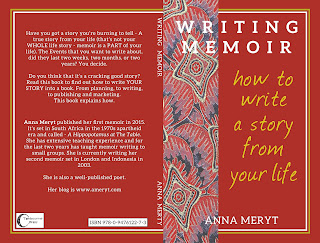My new book, published January 2018.
Writing Memoir. How to Tell a Story from Your Life.
You can buy it on Amazon. [25th Jan 2018 - Hold that thought - I've currently had to suspend print book sales due to problems with the cover. These are being fixed and will be back for sale on Amazon very shortly. - meanwhile it is still available on Kindle - KDP - CLICK HERE]
Ten points to remember in the art of story telling
and narrative, in memoir writing.
1. A
good plot and well-defined characters, brought to life by dialogue.
Structuring a narrative is the most important thing you’ll do. There’s
the narrative thread, unfolding story, for the whole book. Then
chapter by chapter, building to climactic moments, creating dialogue and
developing characters.
2. Emotional
content Think about the emotional impact of what happened to you. You
really want the reader to ‘get’ that, to be involved from the start. The
emotional content for all the other characters involved comes next and how they
interact with you and each other.
3. Starting
point. Begin at a really interesting point in your story – a pivotal
moment. The story should grip the reader from the opening sentence.
Then work back, showing how the story got to that point..
4. Empathy with
the narrator/protagonist – in memoir, that’s you. This is vital to
keep up reader interest in carrying on reading so they really want to know what
happens to you.
5. Mood changes
– that’s not your mood, it’s the mood changes of the story. If
you have something dramatic happen, which carries on for a few chapters until
it’s resolved, maybe you need a chapter where everyone calms down, here and
there.
6. How to end a
chapter? Each chapter should end in such a way that the reader
HAS to turn to the next page to find out what happened next. The links
between chapters should flow smoothly.
When
I wrote my first memoir, my editor told me. ‘It’s like a series of anecdotes’.
So I went back and re-wrote beginnings and endings of chapters so it flowed
more smoothly.
7. Your story
is unique, whatever the genre. Build the reader's involvement slowly, take
them down a few tangents. Don’t reveal it all straightway, so it's not
clear where the story’s going. Keep some surprises for the end.
Build the reader's anticipation.
8. Setting is important, culture, country,
rural, urban. Your story will start/end in a specific
place. Think about the place and how the characters move around the
objects – it’s like writing a scene for a play.
9. Colour,
sound smell. Make your references to these unusual and un-clichéd.
Don’t for example refer to the sparkling turquoise sea, or the white
glare of the sun. Try and think of unusual ways to say these things.
10.Endings: If you set
up a puzzle or conundrum or mystery about what’s happening in your story,
keep teasing the reader about how it’s going to end. The story should move
towards some kind of resolution, some kind of satisfaction of the plot that
ties together the whole story. You can do this just as well with memoir as with
fiction.
